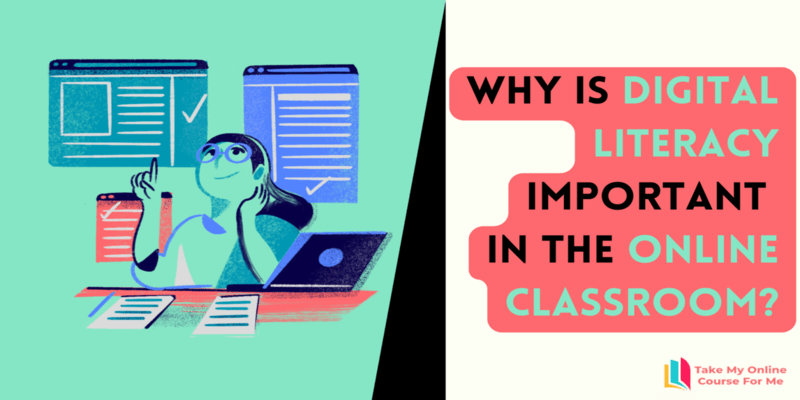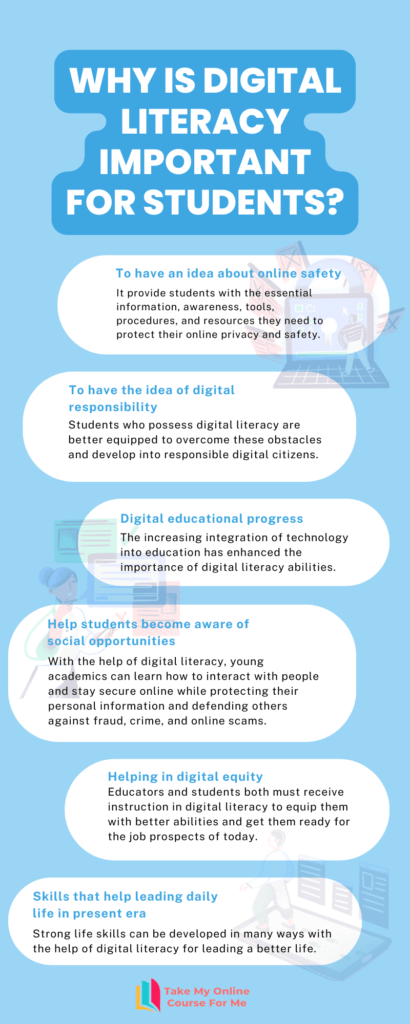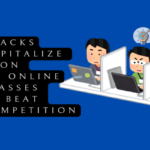
Table of Contents
ToggleDigital literacy has emerged as a vital skill for students in the quickly changing digital age, where knowledge is accessible with just a click and technology permeates every part of our lives. A broad range of skills is included in digital literacy, which gives pupils the ability to interact, understand, and navigate the digital environment. We also observed how the recent pandemic (COVID-19) affected us, mainly the conventional study methods needed to put on a halt due to it. In that situation, it was challenging, still, both students and instructors had to take up the online way of learning and teaching to keep the education sector thriving. Thus, the importance of digital literacy in online classroom is undeniable and institutions across the world are trying to incorporate it as much as possible to provide top-notch distance learning opportunities to academics.
Along with its value addition, there are some unique challenges that technologists along with educators are trying to sort out. If you are among those students pursuing an online course and facing challenges managing your online classes thinking it would have been great if I had someone to take my online course for me, this is the blog you need to take a look at. After investing 10 minutes of your time reading this piece ideated by the experts’ team at TakeMyOnlineCourseForMe, you will get to know the importance of digital literacy in an online classroom, ways to develop digital literacy skills for online learning, and so on.
What is Digital Literacy?
To put it simply, digital literacy is a skill to generate, access, and share information using technology – including digital devices, software, and internet resources.
Digital literacy, according to Microsoft, is the capacity to employ reading, writing, technical proficiency, critical thinking, and other skills to traverse our digital environment. It uses technology to locate, assess, and share information, including computers, cell phones, e-readers, and more.
As per the new educational framework, digital literacy is a critical 21st-century skill that every student has to have to succeed in the quickly evolving digital world. On the other side, digital classrooms utilize technology to improve teaching and learning, including computers, laptops, tablets, and the Internet. With the help of a plethora of online resources and tools, including games, simulations, films, and exams, learning can grow more dynamic and interesting for students in digital classrooms.
Incorporating digital classrooms and digital literacy into the new educational system has many advantages. Additionally, with apt digital literacy skills, students will surely possess enhanced research skills and increased communication skills.
Read more: How Online Programming Class Help You Earn High Grades in Academics?
Why is Digital Literacy Important for Students?
We are all aware of how crucial digital literacy is in the modern world, given how integral technology is to our daily activities, including social relationships and education.
In the increasingly clogged digital environment, effectively identifying and authenticating information is critical. In addition, digital literacy includes safeguarding personal information, staying safe online, and effectively utilizing hardware and software—not just in one’s personal life but also in one’s academic and professional ones.

Let’s find out the importance of digital literacy in a student’s life:
To have an idea about online safety
Because malevolent individuals or organizations are always coming up with new ways to take advantage of others, the risks connected to using the internet are ever-changing. While digital literacy may not provide complete protection against online safety risks, it can provide students with the essential information, awareness, tools, procedures, and resources they need to protect their online privacy and safety.
To get the idea of digital responsibility
Digital responsibility, which includes sharing and consuming information online in an ethical manner, is another aspect of digital literacy abilities. Students are faced with several issues as their reliance on technology grows, including plagiarism, cyberbullying, confirming the reliability of information sources, and acting appropriately in social situations. Students who possess digital literacy are better equipped to overcome these obstacles and develop into responsible digital citizens.
Digital Educational Progress
The increasing integration of technology into education has enhanced the importance of digital literacy abilities. Even in K–12 education, computers, tablets, and the internet have gained popularity during the last ten years. With the organized approach it provides to familiarize oneself with the digital world, digital literacy skills help students feel at ease and competent when utilizing online learning environments. Conversely, people without this ability could find it difficult.
Furthermore, students must have the self-assurance to maintain attention and avoid becoming side-tracked by technology because the majority of standardized tests are now given online.
Making students aware of the social opportunities
Social connections in the modern era take place online, and this trend will see a steep rise. Before friendships and family ties depended on sluggish, conventional forms of communication like telegram and letters, but the advancement of technology has removed these barriers and created a massive global social network. Certainly, social media makes it easier to connect with people outside of one’s immediate physical location and helps build better collaboration skills. But it puts individuals in unstable social situations often – children especially. With the help of digital literacy, young academics can learn how to interact with people and stay secure online while protecting their personal information and defending others against fraud, crime, and online scams.
Helping in digital equity
The ability to bridge the digital divide is another benefit of digital literacy, particularly for working professionals. Even though technology is widely used in homes and classrooms, many young professionals and students lack digital literacy and online etiquette.
Educators and students both must receive instruction in digital literacy to equip them with better abilities and get them ready for the job prospects of today.
Skills that help lead daily life in the present era
Strong life skills can be developed in many ways with the help of digital literacy. Teaching young ones how to collaborate with others using digital technologies and giving them the capacity to express themselves effectively online, helps improve communication skills. The ability to assess the validity and dependability of online information is another way that digital literacy can enhance critical thinking abilities. It can facilitate the growth of creative thinking and problem-solving abilities by teaching people how to utilize digital technology tools, navigate them, solve technical problems, and create and share multimedia material.
The definition of digital literacy changes based on factors including age, location, local customs, and situation. The lack of access to technology in recent years is no less than keeping an entire group of learners in the darkness as they miss out the learning opportunities.
Suppose you are digitally aware of things happening around you yet do not know how to manage your math class as you face continuous challenges understanding specific steps and formulas – how it may feel? Too uncomfortable, isn’t it? You may not know just by typing Do my online math class on Google can help you find professionals attending your class and help you save important credits. Yes, it is truly possible and can be considered as one of the awareness that many students do not know. Seeking help through the Internet for those critical classes is also available from professionals at a very pocket-friendly cost and at any time. Additionally, none can find out that someone else is taking the class for you as the service is provided through an IP address-making facility. If facing issues, connect with the experts right away to balance your online learning today.
Read more: The Benefits of Online Classes for Working Professionals
What are the Challenges of Digital Literacy?
When learning or teaching digital literacy, teachers and students may encounter several obstacles. These include things like not knowing how to use the internet ethically, not having direction, having trouble sifting through the deluge of information available online, and more.
Let’s dive deep to understand these challenges:
Lack of technology awareness and access to it
A key barrier to digital literacy is the need for a certain degree of technical knowledge and proficiency. The inequity of access to advanced technology and tools, coupled with inadequate training, can lead to a digital divide whereby certain individuals possess comparatively lower levels of digital skills and knowledge than others. This may have negative effects on one’s ability to participate in social and political life, find work, and attend school.
The challenge in locating the appropriate source
The inability to locate the appropriate resource among the billions of sources available online is another obstacle to digital literacy. With so much information available, it can be challenging to determine which sources are reliable and authentic. To assess the quality of information found online and distinguish between biases, disinformation, propaganda, and facts and opinions, one needs improved critical thinking skills and analytical capabilities to differentiate. This entails a critical method based on awareness, knowledge, and experience.
Insufficient guidance
Talking about digital literacy raises more privacy and security concerns. Many people use the internet without the guidance of a digital specialist and are unaware of the potential risks. Digital literacy is a problem that requires more attention than we may realize because there is a dearth of knowledge about it among educators and practitioners.
Insufficient knowledge and interest in digital technology
Another problem is the ignorance and disinterest of some groups in digital technology, especially among women and elderly persons. The majority of people on the planet still do not utilize the internet. Africa leads the globe in the percentage of individuals without access, even though Asia has the largest number of unconnected people.
In addition, there is a global gender gap in the number of male internet users in digitally linked nations. This “digital divide” refers to more than just the difference between people who can access the internet and those who cannot. The quality of digital infrastructure in rural communities, the speed of connectivity in remote places, and the knowledge and abilities needed to use such technology are only a few of the disparities that are included in the gap.
Lack of emphasis on digital literacy in education
The drive towards making students digitally literate is highly missing in most of parts of the world. Even if there is a requirement of prominent growth in digital skills within the job market, schools and colleges across the globe do not focus on providing proper digital literacy training. This causes a deficiency of digital skills among young academics and probably will hamper their future employment capabilities.
Implementation is an issue due to its high pricing
Digital classroom implementation can be costly, and educational institutions might not have the funds available to purchase the essential equipment.
Whether children’s mental health is being impacted by their massive daily screen usage is the ultimate question. It was discovered that children and teenagers who report using media more frequently also had higher rates of mental health problems. Parents and educators must ensure that there is a healthy balance between technology and in-person connections because this has intensified the worry that children’s social and cognitive development has also been hampered by too many digital interactions.
Did you also spend much time playing online games or browsing social media forgetting you have an online biology class the next day? Thinking I wish I could pay someone to do my online biology class for me – you can surely do that by hiring an online class help service. Get an expert from their list of professionals available to attend your class and be stress-free. Experts having experience in using top LMS like Canvas, Blackboard, etc will attend your class seamlessly and provide you with any notes that the instructor shares during the class.
Closing
The greater the degree to which technology enters both adults and children’s daily lives, the more crucial it is that students acquire digital literacy abilities. Even though technology is always evolving, students who have a foundation in digital literacy will have the fundamental knowledge and abilities to use a variety of technologies both now and in the future. For example, gaining an understanding of fundamental ideas like input/output, application operation, identifying hardware devices and how to use them, etc., can provide you with a foundational understanding that you can use for new and developing technologies.
Proficiency with technology is becoming a prerequisite for success in today’s world, spanning from social media to education, entertainment, and the workplace and the process of better understanding and grabbing must be initiated by making aware students of digital literacy in online classroom.
Read more: How to Stay Motivated When You Study College Online?
Frequently Asked Questions
| Question 1: Is it important to possess both digital literacy and digital skills? Answer: People with digital literacy skills are better able to comprehend the need to protect their online identity and the possible dangers of cyberattacks. It lets people secure their digital assets with tools like firewalls, antivirus programs, and two-factor authentication. |
| Question 2: What are the key objectives of digital literacy? Answer: The main goal of putting in place a thorough digital literacy program is to enable people to interact with digital technologies in a purposeful, moral, and professional manner, therefore making a significant contribution to the changing global community. |
| Question 3: What are the three main principles of digital literacy? Answer: Digital literacy encompasses three primary skill sets. These include the ability to create, consume, and communicate. In everyday life, each of these skill sets is crucial. |

